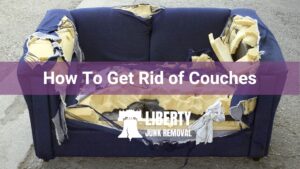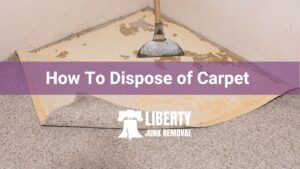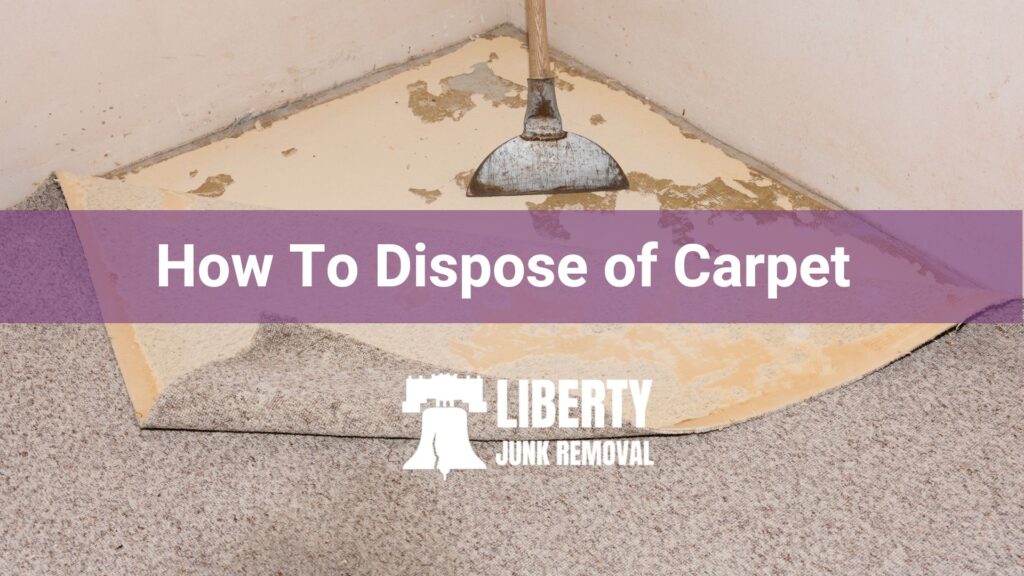So, you’ve got an old carpet. It’s been underfoot for years, and now it’s time to say goodbye. Simple, right? Wrong. Synthetic fibers like nylon and polyester don’t just disappear; they linger and contribute to waste and environmental damage. And let’s not forget the legal tangle. Miss a local disposal regulation, and you could be in for more than just a headache.
If you’re seriously considering disposing of your old carpet, this guide has all the answers you need to know about “How to dispose of carpet?” and more.
Understanding Carpet Disposal
Carpets are often made of synthetic fibers like nylon, polypropylene, polyester, and acrylic, which are non-biodegradable and can take hundreds of years to break down in landfills. Improper disposal contributes to emissions and the spread of microplastics, which are harmful to the environment and wildlife.
The environmental impact of carpet waste is considerable, with millions of tons ending up in landfills or being incinerated, releasing greenhouse gases and toxic pollutants. Therefore, opting for recycling or upcycling can significantly reduce these negative impacts.
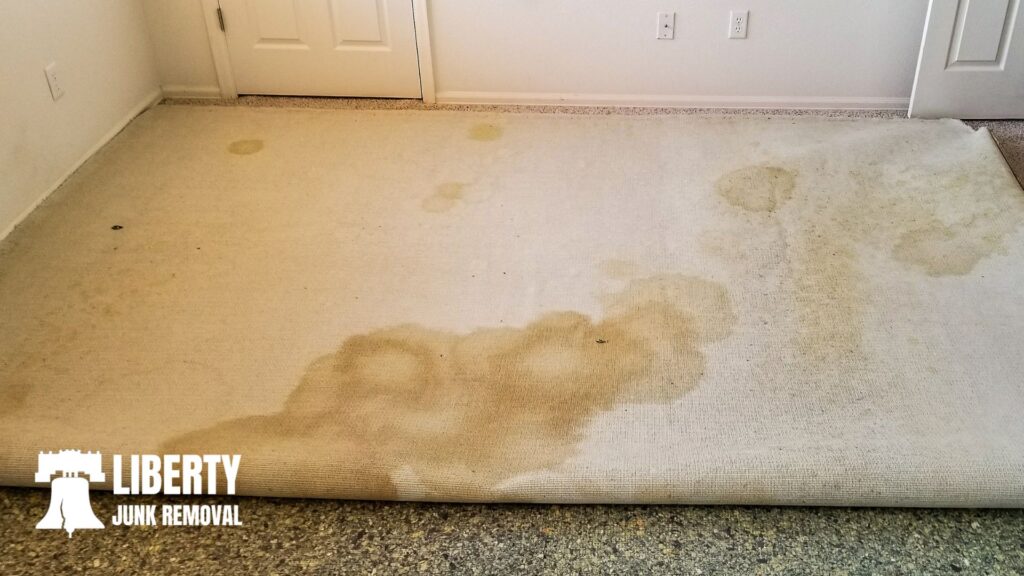
Professional Carpet Disposal Services
Hiring a professional junk removal service for carpet disposal offers convenience and safety. DIY carpet removal can be strenuous and even dangerous, involving risks like sharp nails and tack strips.
Professional services provide fast, friendly, and environmentally safe carpet removal for various types, sizes, and conditions of carpet. These services can be especially beneficial for larger projects like apartment turnovers or commercial property renovations, where the volume of carpet to dispose of can quickly accumulate.
We at Liberty Junk Removal, a premier junk removal company in Philadelphia, offer professional carpet disposal. We are equipped to handle various types of carpets and ensure safe, efficient removal. Moreover, our focus is on recycling and repurposing materials by ensuring sustainable disposal methods. We offer transparent pricing based on the volume of junk. Check out our page for updated pricing and a list of other services.
DIY Carpet Removal and Disposal
Removing a carpet by yourself is a cost-effective way to prepare your space for new flooring.
Here’s a step-by-step guide on how to get this done:
1. Prepare the Room
Clear the space by removing all furniture and any doors that swing into the room.
Wear protective gear such as safety gloves, knee pads, and a dust mask to protect yourself from stray tacks and dust particles.
2. Detach Carpet from Tack Strip
Carpets are usually held in place by tack strips along the room’s perimeter. Start in a corner, using pliers to pull the carpet away from the tack strip. If it doesn’t come up easily, cut a small section with a utility knife for better grip.
3. Cut Carpet into Strips
Roll back about 3 feet of carpet and cut it along the fold using a utility knife, cutting from the back of the carpet. Roll up the cut sections and secure them with duct tape for easier disposal.
4. Remove Carpet Padding
If there’s carpet padding, remove it in a similar fashion. You can remove any staples or glue that are holding it down by using a floor scraper or pliers.
5. Remove Tack Strips (if Necessary)
If installing a different type of flooring, remove the tack strips using a pry bar. Be cautious of sharp tacks and potential wood splinters.
6. Dispose of Old Carpet and Padding
You can typically dispose of the rolled-up carpet and padding on waste pick-up days. Check with your local waste management services for large quantities of carpet disposal. Some areas might have carpet recycling options, turning old carpets into new products.
7. Inspect and Repair Subfloor
Once the carpet is removed, inspect the subfloor for any damages or squeaks. Make necessary repairs to ensure a solid base for new flooring.
To prepare your old carpet for disposal, do the following:
- Start by cutting it into manageable sections. This makes it easier to handle and transport. Use a sharp utility knife for cutting, and ensure you’re wearing heavy-duty gloves for protection.
- Once cut, roll the carpet sections and secure them with duct tape or carpet tape. If your carpet is large or heavy, you might need assistance in rolling it up.
- After rolling, label the rolls for easy identification during disposal. It’s important to consider disposal options such as curbside pickup, recycling, or donation to minimize waste and contribute to a cleaner environment.
Recycling Options for Old Carpets
Almost all types of carpet can be recycled, although the process varies depending on the carpet’s material and construction. Carpets are typically made from various fibers, like nylon, polypropylene, and polyester. These materials can often be broken down and reused to create new products.
However, due to the complex nature of carpets, which often consist of multiple components with different chemical makeups, recycling them can be challenging. It’s essential to identify the type of fiber your carpet is made from to determine the most suitable recycling process.
Finding Local Carpet Recycling Facilities
To find local carpet recycling facilities, you can start by consulting with your carpet dealer, as they might have insights into local recycling options. Additionally, the Carpet America Recovery Effort (CARE) is a nonprofit organization working to develop efficient carpet recycling
infrastructure across the U.S. CARE provides a network of recyclers that turn old carpets into raw materials for new products, like composite lumber and carpet padding. You can use their online resources, such as the recycle center locator, to find a carpet recycling facility near you.
Donation and Reuse of Old Carpets
When considering donating old carpets, it’s important to find a charity that has a specific need for them. Generally, carpets that are in “good used condition or better” are acceptable for donation.
This means they should be clean, free of major wear and tear, stains, or damage. It’s crucial to ensure the carpet does not burden the charity with an item that cannot be used or resold.
For valuable carpets, like antique rugs, it’s advisable to find organizations experienced in handling such items. If you plan to claim a tax deduction for your donation, ensure you obtain a receipt that details the carpet’s description and the donation date. If the carpet is valued at over $250, ask the organization for a written acknowledgement.
Locating Charities and Organizations for Carpet Donation
Finding charities that accept carpet donations can be a bit of a challenge. However, some organizations, particularly those that assist low-income families with housing, may accept new or gently used carpets.
Habitat for Humanity ReStores, for example, are known to accept a variety of donated items, including new and gently used building materials, furniture, and appliances, though their specific needs can vary by location.
It’s advisable to contact local charities or organizations like Habitat for Humanity to inquire about their specific donation criteria and needs. Remember, used carpets typically cannot be donated due to health concerns, so this option is more viable for new or unused carpets.
Creative Ideas for Reusing Old Carpets
There are numerous creative ways to repurpose old carpets, turning them into functional and decorative items. Here are some innovative ideas:
- DIY Upcycled Rug Ottoman: You can transform an old ottoman by reupholstering it with carpet pieces. This can give a dated piece of furniture a modern and unique look.
- Repurposed Carpet Boots: Create fashion statements by decorating boots with strips of old carpet, along with other embellishments like tassels, lace, and rhinestones.
- DIY Upcycled Carpet Scratching Post: For cat owners, old carpets can be converted into scratching posts. You just need a sturdy base and a post, then wrap the carpet around it for your cat to enjoy.
- Repurposed Carpet Strip Window Screen Cleaner: Use cut strips of old carpet to clean window screens. The texture of the carpet is effective in removing bugs and dust from screens.
- Upcycled Carpet Drink Coasters: Convert old carpet into coasters. Carpets are great for absorbing liquid, making them ideal for this purpose.
- Easy DIY Carpet Floor Mats: Old carpets can be cut and shaped into custom floor mats for cars. This not only recycles the material but also adds a personalized touch to your vehicle.
- Pottery Barn-inspired Upholstered Headboard: Use old carpets or small rugs to upholster headboards. This can give your bedroom a unique and plush look.
- Repurposed Carpet Stool: Cover stools or benches with old carpet for a comfortable and decorative seat.
- Upcycled Carpet Scrap Door Mat: Make custom door mats from old carpet scraps. You can personalize them with paint for a unique entrance accessory.
- Carpet Garden Helpers: Use scraps of carpet in the garden under your knees to protect your clothing and provide cushioning while working.
- Upcycled Carpet Compost Insulation: Carpet pieces can insulate compost piles, maintaining the right temperature and keeping pests out.
- DIY Upcycled Carpet Furniture Movers: Place strips of carpet under furniture legs to protect floors from scratches and make moving furniture easier.
Special Cases: How To Dispose of Carpet with Hazardous Materials
When disposing of carpets that contain hazardous materials, it’s crucial to handle them responsibly to prevent harm to both the environment and human health. Carpets made from oil-based materials degrade slowly and release dangerous chemicals into the ground.
If incinerated, they can emit hazardous substances such as lead, mercury, and dioxin into the air, potentially causing serious health issues like asthma, cancer, heart attacks, pulmonary disease, and stroke.
It’s important to note that recycling can sometimes offer a solution to this problem. Carpet fibers can be transformed into raw materials for the production of new carpets or other textile products. They may be processed into pellets or fibers that can be spun into new yarns.
In some cases, carpets that cannot be effectively recycled may be used as a source of energy through incineration or co-processing in cement kilns. However, it’s essential to follow the correct procedures and regulations for this type of disposal.
When deciding how to dispose of a carpet with hazardous materials, consider the following steps:
- Explore recycling options
- Consult local waste management
- Hire a junk removal company
- Avail of manufacturer take-back programs
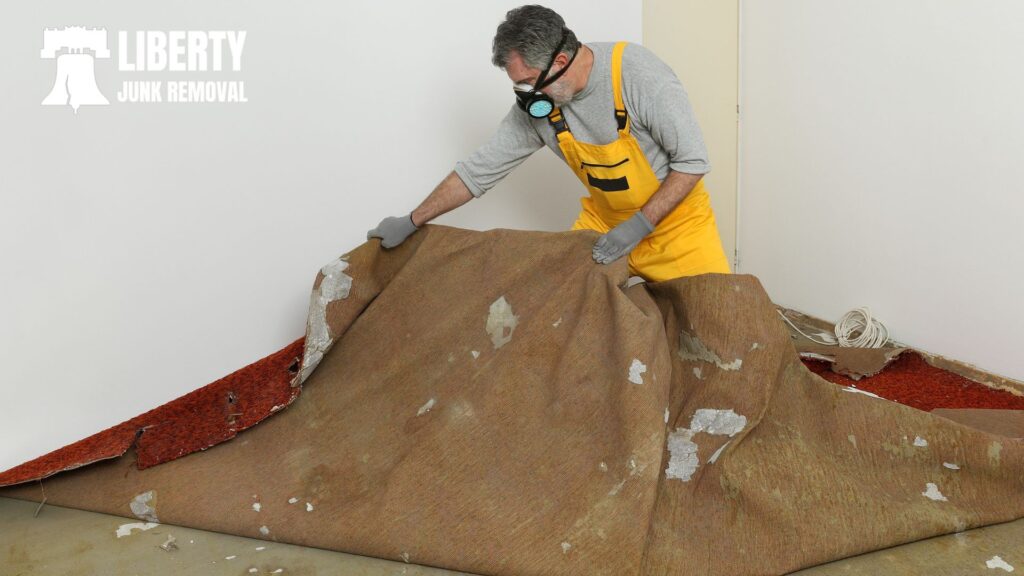
Disposing of Carpets After Water Damage or Mold
When dealing with carpets that have sustained water damage or have mold growth, it’s essential to determine whether the carpet is salvageable or if it should be disposed of. The decision depends on various factors, including the source and duration of water exposure and the presence of mold.
Determining Salvageability of Wet Carpets
- Source of Water: Clean water from sources like a burst pipe is less harmful than contaminated water from sewage or floods. Carpets exposed to clean water have a higher chance of being saved.
- Response Time: Quick action improves the likelihood of saving the carpet. If a carpet remains wet for more than 48 hours, it’s prone to mold growth, making it unsalvageable.
- Extent of Damage: Check for the extent of water penetration and damage. Delamination (separation of carpet layers) or extensive water damage often necessitates replacement.
- Mold Growth: Mold can start growing within 24 to 48 hours of water exposure. If you notice mold, it’s typically better to replace the carpet for health reasons.
Steps for Drying Out Wet Carpet
- Remove excess water using a wet/dry vacuum or carpet extractor.
- Lift the carpet edges to aid air circulation, and use fans and dehumidifiers to speed up drying.
- After drying, consider steam cleaning to sanitize the carpet.
- Continuously monitor for signs of mold. If mold appears, replacing the carpet is advisable.
Water-damaged carpets can become breeding grounds for mold and mildew, posing respiratory risks and allergies, especially if the water is contaminated. It’s crucial to ensure thorough drying to prevent mold growth and protect health.
In cases of severe water damage or when dealing with contaminated water, it’s advisable to seek professional help. Water restoration and cleaning companies can assess whether the carpet can be saved and carry out appropriate remediation.
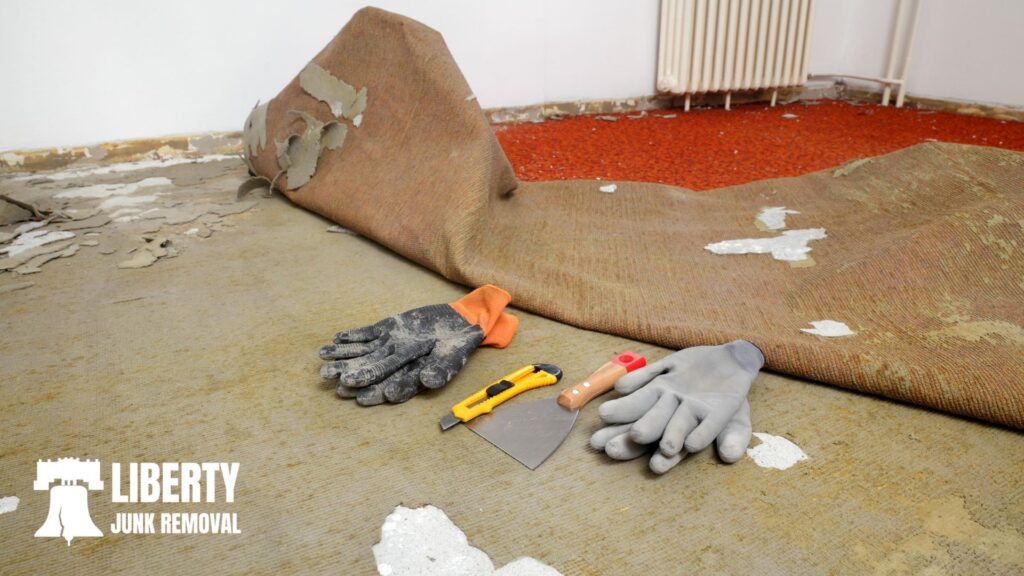
Disposal of Unsalvageable Carpets
Carpets that cannot be salvaged should be disposed of responsibly. Check with local waste management for guidelines on disposing of water-damaged or mold-infested carpets.
Special Considerations for Commercial and Large-Scale Projects
Disposing of carpets in commercial and large-scale settings involves several unique considerations compared to smaller residential projects:
Manufacturer Take-Back Programs
In commercial settings, one effective approach is to engage in manufacturer take-back programs. These arrangements can be particularly beneficial, as they often eliminate the need to establish separate recycling contracts for carpet disposal.
Negotiating with Building Managers
For businesses leasing office space, it’s beneficial to work with building managers to adopt environmentally preferable practices, such as purchasing or leasing carpet made with recycled materials.
Choosing Environmentally Preferable Carpeting
When sourcing new carpets, specify those that can be recycled and contain recycled materials. Carpets with recycled nylon 6, for instance, can be economically recycled back into carpet fiber. Avoid carpets containing PVC due to environmental concerns.
Structured Bid Solicitation
When soliciting bids for carpeting, it’s crucial to specify the environmental standards expected, including the recycling of old carpet and the procurement of carpets with recycled content. This helps support the market for recyclable materials and conserves resources.
Government Initiatives and Legislation
Be aware of state-specific guidelines and initiatives for carpet disposal. Some states, like Minnesota, have specific guidelines for carpet procurement, requiring contractors to reclaim or recycle existing carpets regardless of the manufacturer, fiber type, or construction.
Large-Scale Recycling and Reuse
The industry is seeing an increase in the capacity for recycling carpets, as well as the development of end-user markets for recycled products. This trend is particularly evident in states like California, where significant efforts are being made to keep carpets out of landfills and to increase recycling rates.
Challenges and Innovations in Recycling
The recycling process for carpets can be complex due to the variety of materials involved. New technologies and processes are being developed to improve the efficiency of carpet recycling. Companies like Aquafil are emerging as significant players in the recycled nylon stream, offering innovative recycling solutions.
Carpet Disposal: The Eco-Friendly Way
Carpet disposal isn’t just about getting rid of old stuff. It’s about responsibility. Carpets, made of materials like nylon and polyester, stay for centuries, which causes harm to the environment. As much as possible, don’t just dump; recycle.
If you’re not sure how to do this, that’s where we come in. At Liberty Junk Removal, we handle carpet disposal the right way. We’re experts in eco-friendly disposal, so we know how to get rid of your carpets without hurting the planet.
Our service is straightforward and honest. No hidden fees. Just responsible disposal at a fair price. We’re licensed and insured in Philadelphia, ready to help homeowners, business owners, and construction sites.
Got a carpet you need to get rid of? Contact us. Let’s do this the right way.



